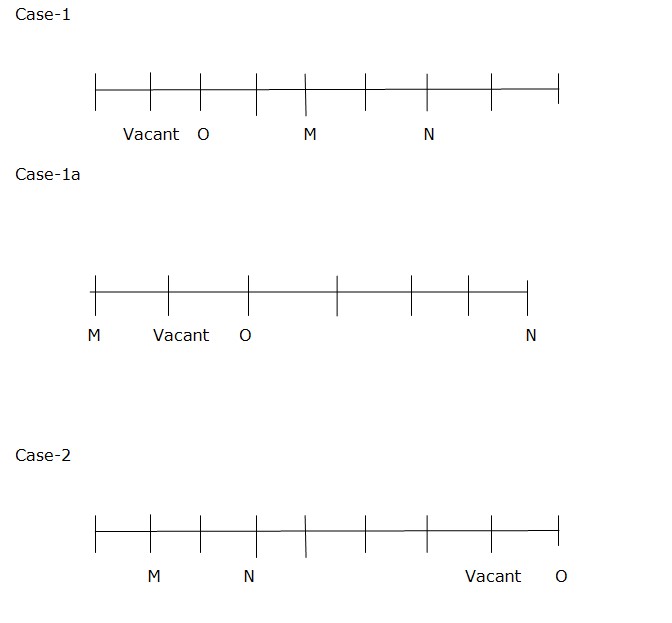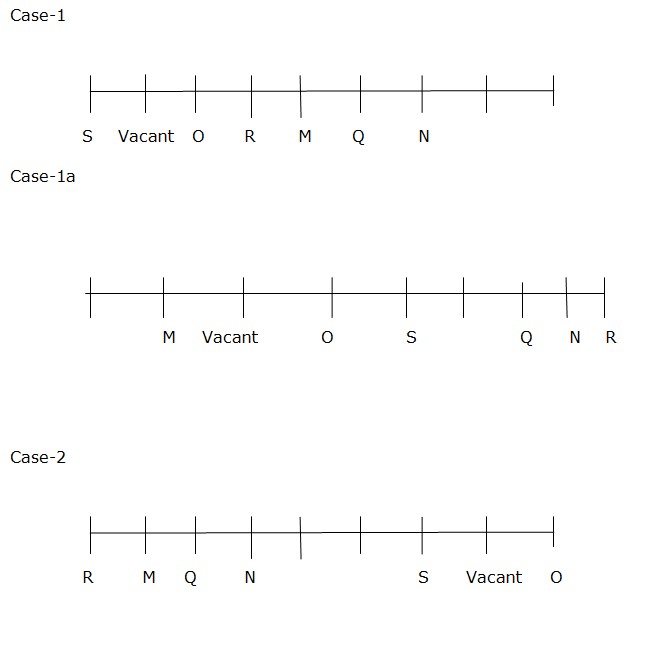Question
What is the position of Q from the left end?
Study the following information carefully and answer the questions given below. Eight friends – M, N, O, P, Q, R, S, and T, are seating on nine seats in a straight line at an equal distance but not necessarily in the same order. One seat in the row is vacant. All of them are facing north directions. There are three persons sit between O and N. The person who sits two places away from N sits fourth to the right of M. M sits neither adjacent to O nor adjacent to S. The person who sits immediate left of the vacant seat sits two places away from O. Q does not sit adjacent to O. R sits two places away from Q. The number of persons who sits between N and R is one less than the number of persons who sits between S and Q. M does not sit at the end. T sits adjacent to N. The number of persons who sits between Q and P is same as the number of persons who sits between T and O. Q does not sit right of N.Solution
There are three persons sit between O and N. The person who sits two places away from N sits fourth to the right of M. M sits neither adjacent to O nor adjacent to S. The person who sits immediate left of the vacant seat sits two places away from O.  Q does not sit adjacent to O. R sits two places away from Q. The number of persons who sits between N and R is one less than the number of persons who sits between S and Q. M does not sit at the end. Q does not sits right of N.
Q does not sit adjacent to O. R sits two places away from Q. The number of persons who sits between N and R is one less than the number of persons who sits between S and Q. M does not sit at the end. Q does not sits right of N.  T sits adjacent to N. This eliminates case 1a. The number of persons who sits between Q and P is same as the number of persons who sits between T and O. This eliminates case 1 and 1a. so final case-2 Case-2
T sits adjacent to N. This eliminates case 1a. The number of persons who sits between Q and P is same as the number of persons who sits between T and O. This eliminates case 1 and 1a. so final case-2 Case-2 
Select the number from among the given options that can replace the question mark (?) and continue the given series.
6, 27, 128, 629, ?
In the following question, a group of letters is given which are numbered 1, 2, 3, 4, and 5. Select that combination of numbers so that letters arranged...
During lunch break, eight colleagues, namely A, B, C, D, E, F, G and H are sitting in a circle facing the centre at equal distances. B is an immediate n...
Choose the correct option figure which will continue the same series as established by the problem figure:
What should come in place of the question mark (?) in the given series based on the English alphabetical order?
YFD, VJA, SNX, PRU.?
In A CERTAIN Code language, ‘bike roads highways cars’ is written as ‘od lk sk jk’. ‘jeep scooter highways bus’ is written as ‘mj jk dn ho...
Read the given statements and conclusions carefully. Assuming that the information given in the statements is true, even if it appears to be at variance...
Select the figure that will come in place of the question mark (?) in the following figure series.
In the question below, a few statements are given depicting an issue or a problem. You have to assume everything in the statements to be true even if th...
Statements: Some combs are wood. Some wood are tables. Some tables are plastic.
Conclusion I: Some wood are combs.
Conclusion II: All plastic are tables.
Relevant for Exams:


